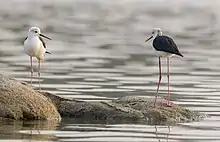Black-winged stilt
The black-winged stilt (Himantopus himantopus) is a widely distributed very long-legged wader in the avocet and stilt family (Recurvirostridae). The scientific name H. himantopus was formerly applied to a single, almost cosmopolitan species. It is now normally applied to the form that is widespread in Eurosiberia and Africa and which was formerly regarded as the nominate subspecies of Himantopus himantopus sensu lato. The scientific name Himantopus comes from the Greek meaning "strap foot" or "thong foot".[2] Most sources today accept 2–4 species.[3][4][5][6][7][8] It is sometimes called pied stilt, but that name is now reserved for the Australian species, Himantopus leucocephalus.
| Black-winged stilt | |
|---|---|
.jpg.webp) | |
| H. h. meridionalis (South Africa) | |
 | |
| at Ameenpur lake, Telangana, India | |
| Scientific classification | |
| Kingdom: | Animalia |
| Phylum: | Chordata |
| Class: | Aves |
| Order: | Charadriiformes |
| Family: | Recurvirostridae |
| Genus: | Himantopus |
| Species: | H. himantopus |
| Binomial name | |
| Himantopus himantopus | |
 | |
| Range of H. himantopus Breeding Resident Passage Non-breeding | |
| Synonyms | |
| |
Description
Adults are 33–36 cm (13–14 in) long. They have long pink legs, a long thin black bill and are blackish above and white below, with a white head and neck with a varying amount of black. Males have a black back, often with greenish gloss. Females' backs have a brown hue, contrasting with the black remiges. In the populations that have the top of the head normally white at least in winter, females tend to have less black on head and neck all year round, while males often have much black, particularly in summer. This difference is not clear-cut, however, and males usually get all-white heads in winter.
Immature birds are grey instead of black and have a markedly sandy hue on the wings, with light feather fringes appearing as a whitish line in flight.
Taxonomy and systematics
The taxonomy of this bird is still somewhat contentious. It is one of five distinct species which were previously considered subspecies of H. himantopus. H. himantopus sensu lato, is made up of one species and 5–7 subspecies, and was sometimes referred to as common stilt. The name black-winged stilt refers to H. himantopus sensu stricto, with two subspecies H.h. himantopus from the Palearctic and H.h. meridionalis from the Afrotropical region.[9]
Ecology and status
The breeding habitat of all these stilts is marshes, shallow lakes and ponds. Some populations are migratory and move to the ocean coasts in winter; those in warmer regions are generally resident or short-range vagrants. In Europe, the black-winged stilt is a regular spring overshoot vagrant north of its normal range, occasionally remaining to breed in northern European countries. Pairs successfully bred in Britain in 1987,[10] and after a 27-year hiatus there were two instances of successful breeding in Southern England in 2014.[11] 13 young were fledged in southern England in 2017.[12]
These birds pick up their food from sand or water. They eat mainly insects and crustaceans.
The nest site is a bare spot on the ground near water. These birds often nest in small groups, sometimes with avocets.

The black-winged stilt is one of the species to which the Agreement on the Conservation of African-Eurasian Migratory Waterbirds applies.
 Fledgling (Laguna di Venezia, Italy)
Fledgling (Laguna di Venezia, Italy) Juvenile, Perth Zoo
Juvenile, Perth Zoo_immature.jpg.webp)
 Nestling of himantopus. The other taxa look the same at this age.
Nestling of himantopus. The other taxa look the same at this age. In flight (Laguna di Venezia, Italy)
In flight (Laguna di Venezia, Italy) Adults in flight (India)
Adults in flight (India) Adult in Water (Western India)
Adult in Water (Western India) Black-winged stilts Himantopus himantopus in flight at Basai Wetland, India
Black-winged stilts Himantopus himantopus in flight at Basai Wetland, India_fighting.jpg.webp)
_India.jpg.webp)

References
- BirdLife International (2016). "Himantopus himantopus". IUCN Red List of Threatened Species. 2016: e.T22727969A86541570. doi:10.2305/IUCN.UK.2016-3.RLTS.T22727969A86541570.en.CS1 maint: uses authors parameter (link)
- Jobling, James (2010). Helm Dictionary of Scientific Bird Names. London: Helm. p. 191.
- BirdLife International (2008a). "Himantopus himantopus". IUCN Red List of Threatened Species. 2008a. Retrieved 2 January 2009.
- BirdLife International (2008b). "Himantopus leucocephalus". IUCN Red List of Threatened Species. 2008b. Retrieved 2 January 2009.
- BirdLife International (2008c). "Himantopus mexicanus". IUCN Red List of Threatened Species. 2008c. Retrieved 2 January 2009.
- "Species factsheet: Black-necked Stilt". BirdLife International (BLI). 2008d. Retrieved 24 September 2008.
- "Species factsheet: Black-winged Stilt". BirdLife International (BLI). 2008e. Retrieved 24 September 2008.
- "Species factsheet: White-headed Stilt". BirdLife International (BLI). 2008f. Retrieved 24 September 2008.
- "Black-winged Stilt Himantopus himantopus (Linnaeus, 1758)". Avibase. Denis Lepage. Retrieved 19 August 2017.
- Boyd, Bill (1987). "The Black-winged Stilts at Holme Norfolk Naturalists' Trust reserve". Twitching. 1 (6): 148–150.
- RSPB. "27-year first as rare black-winged stilt chicks hatch at RSPB reserves in southern England". RSPB Website. Retrieved 16 November 2015.
- "UK's rare black-winged stilt numbers soar". Countryfile Magazine. BBC. Retrieved 20 August 2017.
Further reading
- Hayman, Peter; Marchant, John; Prater, Tony (1986). Shorebirds: an identification guide to the waders of the world. Boston: Houghton Mifflin. ISBN 0-395-60237-8.
External links
| Wikimedia Commons has media related to Himantopus himantopus. |
| Wikispecies has information related to Himantopus himantopus. |
- "Black-winged stilt media". Internet Bird Collection.
- Black-winged Stilt species text in The Atlas of Southern African Birds.
- Ageing and sexing (PDF; 2.7 MB) by Javier Blasco-Zumeta & Gerd-Michael Heinze
- "Himantopus himantopus". Avibase.

- Black-winged stilt photo gallery at VIREO (Drexel University)
- Interactive range map of Himantopus himantopus at IUCN Red List maps
- Audio recordings of Black-winged stilt on Xeno-canto.
